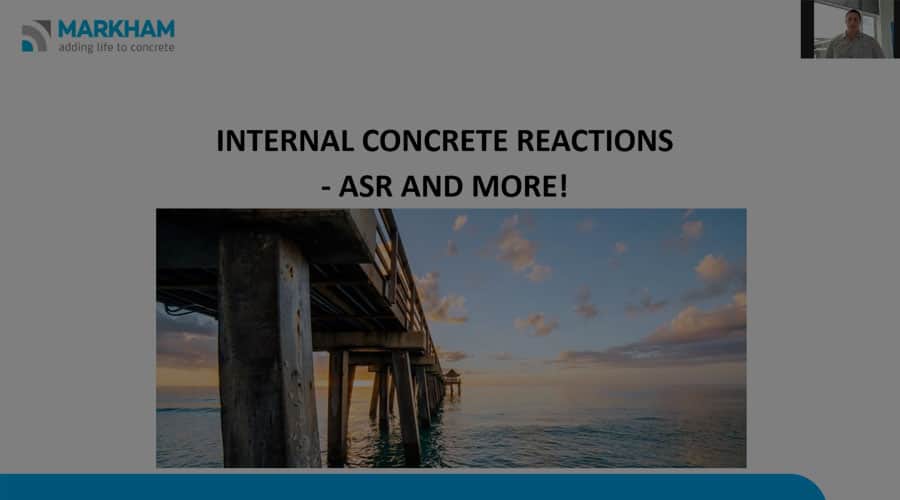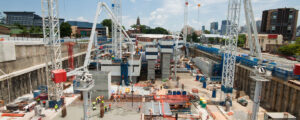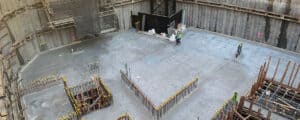Internal Concrete Reactions - ASR & More

Internal Concrete Reactions – ASR & More
Webinar Show Notes
Acid and Effluent Attack markhamglobal.com/concrete-and-agricultural-chemicals-2
Learning Outcomes
- Causes of common issues in concrete infrastructure and the harms caused by them.
- The role of moisture in corrosion and how it can be controlled.
- Colloidal silica hydrogels versus protective coatings.
FINN: I’m Finn Currie from the Napier office here. I’m part of the support team. And today we are visiting Doug Hamlin, who’s one of our project consultants, also from the Napier office. G’day, Doug. How’s it going? Looks like you’re muted.
DOUG: You’d think by now we’ve learned to do that. How are you doing, Finn? Yes, good to be on today, it’s a topic I’m passionate about. I’ve been with MARKHAM for just over 10 years now. So I’ve good some good experience in the space, starting from onsite right through to recommendations and things today. Yes, back to you.
FINN: Yes, today we’re talking about internal concrete reactions. So I’ll be hitting you with some questions later on about the issues that you see in concrete infrastructure, and the MARKHAM systems and our approach to those systems. We’ll also be opening the door for any guest questions. So feel free to pop your questions in the Q&A button at the bottom of your screen as we go along. So Doug, what are internal concrete reactions exactly?
DOUG: Oh yes, good question. So I guess very briefly put, they are reactions that happen on the inside of the concrete, that are not necessarily apparent on the outside or from a visual look on the outside of the concrete, until it’s too late and till they manifest into problems that turn out to be very costly. So things like ASR, where we’ve got reactive materials being used in concrete. Things like corrosion of embedded reinforcing steel, carbonation, and DEF is another internal one. So there’s many mechanisms, and as I say, they all work on the inside of the concrete and kind of damage it from the inside out, if that makes sense.
FINN: So what causes these reactions?
DOUG: Good question as well. So obviously, every damage mechanism is slightly different in the way that it operates. In short, they all call back to or fall back on moisture migration in concrete as the main cause. We’ll see these in a slightly different way that they do that. But if you could take it back to that one factor, that is, it relates back to that moisture movement.
FINN: And why do these reactions matter, do they cause any harm?
DOUG: Yes, they sure so. So we’ll just pick out a couple of examples here. So if we just start with ASR, since this is one of the main topics on today. So ASR is either reactive aggregates or sands that are used in the concrete mix, and over time with moisture, they form a gel and expand inside the concrete. What this does is that it cracks the concrete from the inside, it overcomes concrete tensile forces. What that means is that cracking allows more moisture and more contaminants through the concrete.
Another example is steel corrosion. So that might be in a marine environment, where you’ve got moisture moving through the concrete carrying chlorides. The chlorides attack the steel, break down its natural passivation or protection layer, and cause it to rust more. That expands eventually leading to spalling of the concrete, which needs costly mediation.
FINN: You mentioned that all these reactions are driven by moisture. Can you say a little bit more about that?
DOUG: Yes. So I’ve mentioned that ASR requires that moisture to make that gel expand on the concrete, and without that moisture migration, or that being fed moisture, the ASR reactions don’t happen to the same extent, and we can limit it down so it’s not a cause of concern.
Steel corrosion, we’ll have another look at that. So if you think of corrosion, in very brief terms, as a three part-equation, it needs moisture, it needs oxygen, and it needs some form of acid, whether that’s chlorides or whatever it may be. If you can take the moisture equation out of it, or stop that moisture movement carrying chlorides through the concrete, then effectively … that equation or that corrosion can’t happen inside the concrete. So you’re effectively taking away the main factor, if you like, from that equation.
Another example, which we haven’t touched on yet, is carbonation. So that’s when the atmospheric carbon dioxide mixes with moisture. It forms an acid that migrates very slowly through the concrete, but it still reduces the pH in the concrete. If we’ve got cracking or something like that in the concrete, that acid can get access to the steel and attack that and start that corrosion process again. So yes, does that make sense? Does that help answer your question, Finn?
FINN: Yes, it sounds like a challenging problem. What’s the answer to this problem?
DOUG: Yes, that’s great. It’s something that I’m potentially biased about, but I also believe… I’ve also done a lot of study in this area. But in short, the answer is to waterproof or to stop that moisture migration or moisture movement through the concrete.
Now, there’s many ways to do this; there’s many traditional methods. But if we can stop that moisture migration, we make that cover concrete really do its job; cover concrete is there to protect the reinforcing steel. If we can protect that and make that waterproof, stop that moisture moving through that cover concrete and reaching that steel with its contaminants, of course, we stop that problem.
Now, the most effective way that I’ve seen to do this is with what we call colloidal silica hydrogels. These can be either added into the concrete mix, or they can be spray-applied retrospectively. Obviously, it depends on the situation as to which way you’d go there. But either way, not only are they cost-effective, but they’re also permanent, so they don’t break down or wear in the concrete.
FINN: Can’t we just protect the structure by painting on a protective coating?
DOUG: That’s a good question, it comes up a lot. That is the traditional modus operandi, it’s the way that protection of concrete has been done for a long time. In short, it’s a great idea, and any protection is better than none, in terms of concrete. But what happens, there’s one fundamental issue straightaway. That is, if you’re talking about a structure that’s already got damage, so where you’ve already got some reinforcing corrosion, putting a coating over the top, that’ll stop more ingress of chloride. But it doesn’t stop the chlorides or the damage mechanisms inside that are already happening, or the corrosion that’s already happening inside.
So versus that, compared to a hydrogel, that gets around the critical area of the steel, and stops or halts that corrosion process in its tracks, versus just being one barrier at the surface. Just further to that, if you’ve got say highly contaminated concrete, or it doesn’t even have to be that highly contaminated, you’ve put a coating on the outside, that’s like putting a raincoat when it’s a hot day outside, your body starts to sweat. Now the concrete does a very similar thing. You can imagine, with that extra heat, and there’s actually extra moisture movement, it actually speeds up that corrosion process.
Secondly, there’s also ongoing maintenance with a topical coating. Whereas with the hydrogel, once the colloidal silica has reacted with the alkalis, and the hydrogel set up, it does become part of the concrete as permanent; you can’t remove it from the concrete matrix.
Now, we’re not totally bagging protective coatings by any means. In some cases, we would actually recommend a hydrogel treatment plus a protective coating, if it’s an extremely aggressive environment. But as standalone protection, our first recommendation is the hydrogel, to keep that internal concrete matrix protected and stop or slow most damage mechanisms down.
FINN: So I guess the earlier the structure is treated, the better?
DOUG: Yes, definitely. Obviously, as I mentioned earlier, we can go in as an admixture in the mix water, with the hydrogel treatment, or we can be spray-applied once the structure is up and going. It can be applied obviously at any time. In short, the best time is on day one when the concrete is in its best condition. So a natural concrete is doing its job of protecting the reinforcing steel, it’s not until these other mechanisms come in and break it down. So if you’ve got the admixture, you’ve got that hydrogel protecting in there from day one, that’s the very best. It’s also the most cost-effective. I mean, if you think about further down the track, you’ve got things like access to think about, and downtime. If it’s an active … it could be a sewer treatment plant, it could be a bridge, it could be a wharf, they’ve all got costs associated with downtime. So yes, definitely, earlier the better.
FINN: Yes, that’s excellent, Doug. Thanks for taking the time to help us all out with that. Looks like we’ve had a couple of live questions as you finished speaking. One of them was, Can you please describe ASR?
DOUG: Yes, sure thing. So ASR is short for Alkali-Silica Reactivity. Obviously, it’s a very big subject, I’ll just cover it off briefly today. But in short, we have got reactive materials or reactive silica in the sands when the concrete is being mixed, and then over time, you’ll get moisture ingress into the concrete. There’s many things you can do to combat it from day one. One of the most popular things is to include fly ash in the mix. But even then, it’s only kind of a one-step you can do; it’s not a full answer.
But that aside, once you get those reactive materials mixing with moisture, what they do is they form a gel and expand. Now concrete is very strong in compression strength; that’s fairly basic there. But it’s not very strong in flexural or tensile loading. So when that gel pushes that concrete apart, that can crack very easily, and that’s where it’s a real problem.
FINN: Okay. One other question is, Does moisture movement or carbon penetration deform the shape of the concrete if it has no reinforcing, and will the hydrogel stop this from occurring?
DOUG: Just so I can rephrase that question. So if there’s no reinforcing steel, will the carbonation still happen?
FINN: Yes, I believe so.
DOUG: Yes, so it will still happen. Carbonation is one of the slowest damage mechanisms out there that’s probably more prevalent in built-out areas with high traffic, that type of thing. But when you have got no reinforcing steel, that will still lower the pH of the concrete, and eventually, lower the pH to the point where the concrete may start to break down. It’s not a real common occurrence. But where there’s no reinforcement, it’s not such an issue; where there is reinforcement, definitely. Because if it gets to that steel and starts that corrosion process, it starts that spalling that cracking we mentioned.
But yes, with no reinforcing, it’s really limited to lowering the pH of the concrete, which eventually will break down but it’s not one of the most pressing mechanisms you might say.
FINN: Okay, so that just wraps it all up. Thanks, everyone for attending this week’s MARKHAM meeting!
DOUG: Awesome! Thank you.
More about MARKHAM
MARKHAM are dedicated to providing innovations for concrete and construction. Focusing on concrete waterproofing solutions, penetrating concrete sealers and durability treatments concrete.




